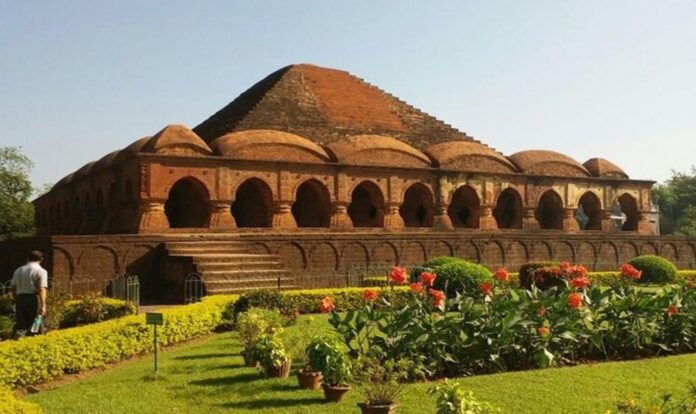Introduction:
Nestled in the heart of West Bengal, India, lies the charming town of Bishnupur, renowned for its rich cultural heritage and historical significance. Steeped in history, this town offers a fascinating glimpse into the art, architecture, and traditions of ancient Bengal. From exquisite terracotta temples to lush gardens and serene lakes, Bishnupur is a treasure trove of attractions waiting to be discovered. Here are five must-visit places in Bishnupur that will leave you enchanted and spellbound.
Rasmancha Temple:
The Rasmancha Temple is an architectural marvel and one of Bishnupur’s most iconic landmarks. Built during the 16th century by the Malla Kings, this unique structure showcases a blend of Bengali and Islamic architectural styles. Its name, “Rasmancha,” translates to “the dance hall of Lord Krishna,” and it was originally constructed to facilitate grand ceremonies during the Ras festival. The temple’s distinctive pyramidal structure, adorned with intricate terracotta carvings depicting scenes from Hindu epics, is a true testament to the artistic finesse of the era.
Jorbangla Temple:
Another masterpiece of terracotta artistry, the Jorbangla Temple, also known as the Keshta Roy Temple, is a visual delight. Built in the 17th century, this temple stands on a raised platform and is characterized by its twin curved roofs, resembling the hoods of a snake. The temple’s exterior is adorned with ornate terracotta panels, narrating stories from the Ramayana and the Mahabharata. A visit to this architectural gem offers a glimpse into the vibrant mythology and cultural heritage of ancient Bengal.
Madan Mohan Temple:
Dedicated to Lord Krishna, the Madan Mohan Temple is an embodiment of serene spirituality. Constructed in 1694, this redbrick temple stands as a serene oasis amid the bustling town. The temple’s tranquil ambiance and intricate terracotta carvings provide a peaceful retreat for visitors seeking spiritual solace. Its architecture reflects the classic Ekaratna (single tower) style, making it a prominent religious site for locals and tourists alike.
Dalmadal Caman:
As you explore Bishnupur, you cannot miss the historical significance of Dalmadal Caman. This massive canon, believed to have been cast during the reign of King Raghunath Singha II, stands as a symbol of the town’s valor and strength. The Dalmadal Caman played a crucial role in safeguarding Bishnupur from external threats and was used in battles during the Malla dynasty. Now a cherished artifact, it serves as a reminder of the town’s glorious past.
Lalbandh:
For those seeking a serene escape, Lalbandh is a picturesque man-made lake surrounded by lush greenery. Created in the 17th century as an irrigation reservoir, this scenic spot now serves as a recreational hub for locals and tourists alike. Boating on the tranquil waters, enjoying a leisurely stroll along the tree-lined pathways, or simply admiring the sunset views, Lalbandh offers a refreshing and peaceful experience.
Conclusion:
Bishnupur’s heritage and culture are bound to captivate the hearts of every visitor. From the grandeur of its terracotta temples to the tranquility of its lakes, the town provides an immersive experience into the rich history of Bengal. A journey to Bishnupur is not only an exploration of architectural brilliance but also an opportunity to connect with the soul of a town that has stood the test of time. So, pack your bags and embark on a journey of discovery through the enchanting town of Bishnupur.


